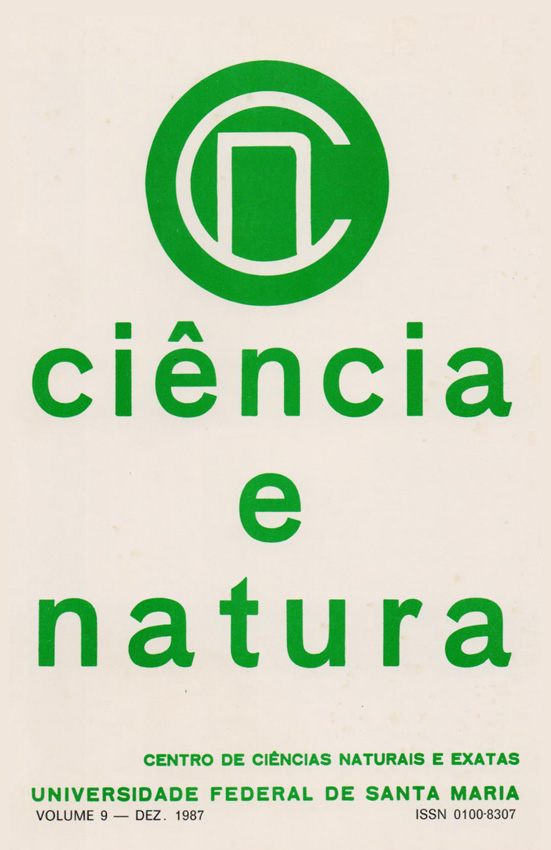Petrografia dos mármores de Caçapava do Sul, RS
DOI:
https://doi.org/10.5902/2179460X25458Resumo
A região de Caçapava do Sul, no Estado do Rio Grande do Sul, é caracterizada pela ocorrência de um batólito granítico (Granito Caçapava) com afloramento de 25 x 10 km, orientado no sentido N - S. O Granito Caçapava é circundado por um cinturão de metamorfitos do Grupo Porongos, e atribuído ao Pré-Cambriano Superior por RIBEIRO et alii(1966). Incluindo nestes metamorficos situa-se um corpo de rochas carbonatadas de aspectos lenticular, com contatos nítidos, interpenetrado por apófises graníticas e com um afloramento de aproximadamente 17 km2. Foram estudados amostras deste corpo de rochas por meio de microscopia, difratometria e espectrometria de raio x, microssonda eletrônica e análise química por via úmida, com o objetivo de identificar e caracterizar os minerais carbonáticos e silicáticos. Por meio de técnicas de coloração, foi possível a distinção de dolomita (Do), calcita (Cc) e calcita ferrífera (Ccf). As análises modal e química indicaram a predominância de carbonatos sobre silicatos, estando estes últimos relacionados mais às bandas das rochas. Os mineirais silicáticos detectados foram: talco, tremolita, diopsídio, forsterita, clorita e flogopita. Em menores quantidades aparecem titanita, apatida e quartzo, sendo comum, também, a serpentina oriunda de alteração da forsterita. Os resultados advindos com o estudo dessas rochas permitiram classificá-las como mármores dolomíticos impuros de contato.
Downloads
Referências
BORTOLOTTO, O.J. Petrologia dos Mármores de Caçapava do Sul, RS. Dissertação de Mestrado. Instituto de Geociências. Universidade de São Paulo. 1986. (Inédito).
CHAVES, F. A simple point-counter for thin section analyses. Am. Miner., 134: 1-11, 1949.
DEER, W.A.; HOWIE, R.A. & ZUSSMAN, J. An Introduction to the Rock-Forming Minerals, Longman. London. 1971.
GIRARDI, V.A. V. Metamorfismo e seus produtos. Curso de Pós-Graduação. Instituto de Geociências, USP. 1979. (Inedito).
HEY, M.H. A new review of the chlorites. Min. Mag. 30: p.277. 1954. (Cit. em DEER et alii, 1977).
HUTCHISON, C. S. Laboratory Handbook of Petrographic Techniques. J. Wiley & Sons. N. York. 1974.
LEAKE, B. E. A catalog of analysed calciferous and subcalciferous amphiboles together with their nomenclature and associated minerals. Geol., Soc. Am. Spec. Paper, 98. 210p. 1968. (cit. em HUTCHISON, 1974).
OLIVEIRA, M.A.F. de - Petrologia das rochas granuliticas da Faixa Paraíba do Sul, Estados do Rio de Janeiro e Minas Gerais. Tese de Livre Docência, UNESP, Rio Claro, SP, 1980. (Inédito).
POLDERVAART, A. & HESS, H. H. Pyroxenes in the crystallization of basaltic magma. Journ. Geol, 59: p.472. 1951. (cit. em. DEER et alii,1977).
RIBEIRO, M.; BOCCHI, P.R.; FIGUEIREDO F., P.M. & TESSARI, R.L. Geologia da Quadricula de Caçapava do Sul, Rio Grande do Sul, Brasil. Div. Fom. Prod. Min., Bol. 127; 232p. 1966.
RIBEIRO, M. Geologia da Folha de Bom Jardim, Rio Grande do Sul, Brasil Dep. Nac. Prod. Min., Div. Geol. e Min., Bol. 247, 142 p. 1970.
WAHLSTROM, E. E. & KIM, O.J. Precanbrian rocks of the Hall Valley Area, Front Range, Colorado. Bull, Geol, Soc. Am., 70: 1217-1244. 1959.
WINKLER, H. G. F. Petrogênese das Rochas Metamórficas. Ed. Edgar Blücher Ltda. S. Paulo. 1977.
WOLF, K. H.; EASTON, A. J. & WARNE, S. Techniques of Examining and Analysing Carbonate Skeletons, Minerals and Rocks. Elsevier Publ. CO. Amsterdam, p. 253-341. 1967.
Downloads
Publicado
Como Citar
Edição
Seção
Licença
Para acessar a DECLARAÇÃO DE ORIGINALIDADE E EXCLUSIVIDADE E CESSÃO DE DIREITOS AUTORAIS clique aqui.
Diretrizes Éticas para Publicação de Revistas
A revista Ciência e Natura está empenhada em garantir a ética na publicação e na qualidade dos artigos.
A conformidade com padrões de comportamento ético é, portanto, esperada de todas as partes envolvidas: Autores, Editores e Revisores.
Em particular,
Autores: Os Autores devem apresentar uma discussão objetiva sobre a importância do trabalho de pesquisa, bem como detalhes e referências suficientes para permitir que outros reproduzam as experiências. Declarações fraudulentas ou intencionalmente incorretas constituem comportamento antiético e são inaceitáveis. Artigos de Revisão também devem ser objetivos, abrangentes e relatos precisos do estado da arte. Os Autores devem assegurar que seu trabalho é uma obra totalmente original, e se o trabalho e / ou palavras de outros têm sido utilizadas, isso tem sido devidamente reconhecido. O plágio em todas as suas formas constitui um comportamento publicitário não ético e é inaceitável. Submeter o mesmo manuscrito a mais de um jornal simultaneamente constitui um comportamento publicitário não ético e é inaceitável. Os Autores não devem submeter artigos que descrevam essencialmente a mesma pesquisa a mais de uma revista. O Autor correspondente deve garantir que haja um consenso total de todos os Co-autores na aprovação da versão final do artigo e sua submissão para publicação.
Editores: Os Editores devem avaliar manuscritos exclusivamente com base no seu mérito acadêmico. Um Editor não deve usar informações não publicadas na própria pesquisa do Editor sem o consentimento expresso por escrito do Autor. Os Editores devem tomar medidas de resposta razoável quando tiverem sido apresentadas queixas éticas relativas a um manuscrito submetido ou publicado.
Revisores: Todos os manuscritos recebidos para revisão devem ser tratados como documentos confidenciais. As informações ou ideias privilegiadas obtidas através da análise por pares devem ser mantidas confidenciais e não utilizadas para vantagens pessoais. As revisões devem ser conduzidas objetivamente e as observações devem ser formuladas claramente com argumentos de apoio, de modo que os Autores possam usá-los para melhorar o artigo. Qualquer Revisor selecionado que se sinta desqualificado para rever a pesquisa relatada em um manuscrito ou sabe que sua rápida revisão será impossível deve notificar o Editor e desculpar-se do processo de revisão. Os Revisores não devem considerar manuscritos nos quais tenham conflitos de interesse resultantes de relacionamentos ou conexões competitivas, colaborativas ou outras conexões com qualquer dos autores, empresas ou instituições conectadas aos documentos.






